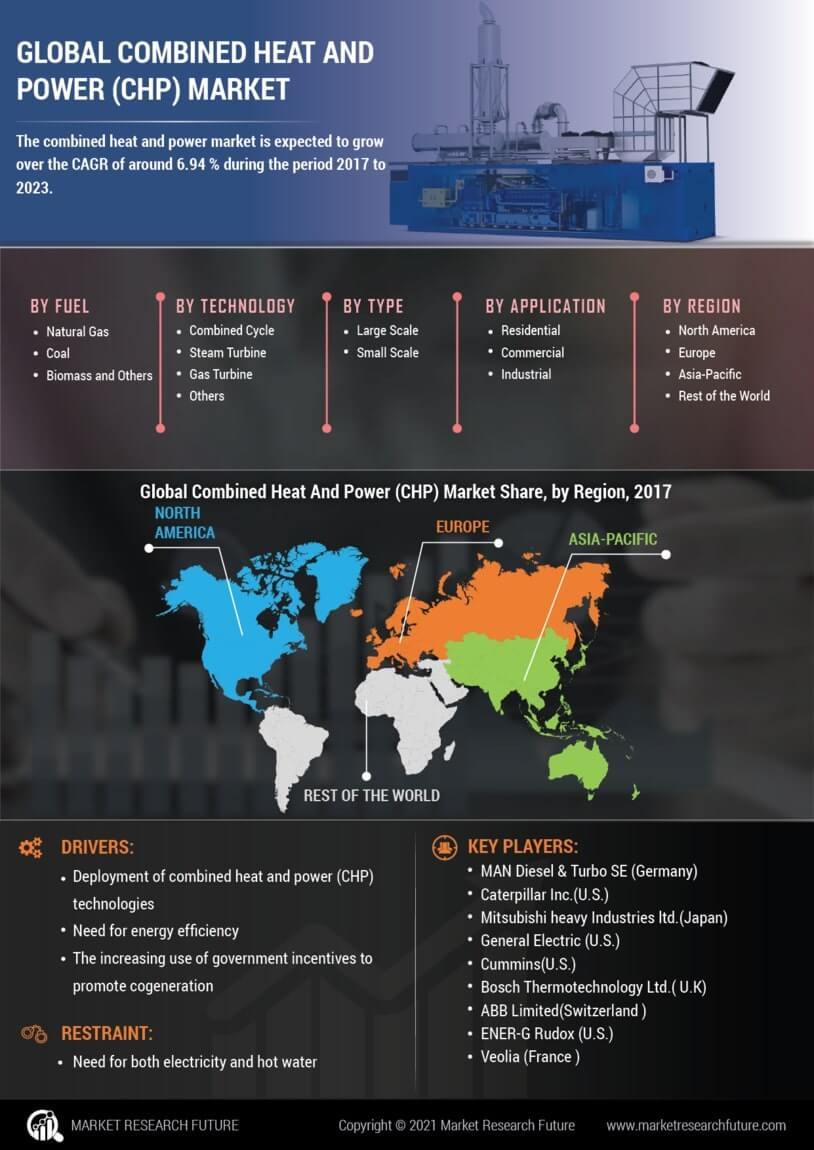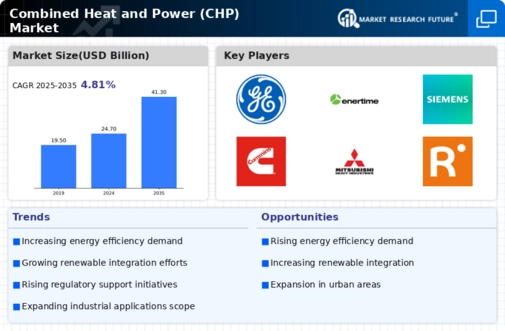Increasing Energy Costs
The rising costs of energy are driving the Combined Heat and Power (CHP) Market towards more efficient solutions. As traditional energy prices continue to escalate, businesses and industries are seeking ways to mitigate these expenses. CHP systems, which generate electricity and useful heat simultaneously, offer a compelling alternative. By utilizing waste heat that would otherwise be lost, these systems can achieve efficiencies of over 80%. This efficiency translates into lower energy bills and reduced reliance on grid electricity. In recent years, the market has seen a notable increase in installations, with a reported growth rate of approximately 5% annually. This trend suggests that as energy prices rise, the adoption of CHP technologies will likely accelerate, further solidifying their role in the energy landscape.
Environmental Regulations
Stringent environmental regulations are increasingly influencing the Combined Heat and Power (CHP) Market. Governments worldwide are implementing policies aimed at reducing greenhouse gas emissions and promoting cleaner energy sources. CHP systems, which can utilize natural gas or biomass, are often viewed as a cleaner alternative to traditional fossil fuel-based power generation. The ability of CHP to significantly lower emissions while providing reliable energy makes it an attractive option for compliance with these regulations. For instance, the U.S. Environmental Protection Agency has recognized CHP as a viable solution for reducing emissions in various sectors. As regulatory frameworks become more rigorous, the demand for CHP systems is expected to rise, as industries seek to align with environmental standards while maintaining operational efficiency.
Technological Advancements
Technological advancements are playing a pivotal role in shaping the Combined Heat and Power (CHP) Market. Innovations in CHP technology, such as improved turbine designs and enhanced heat recovery systems, are making these solutions more efficient and cost-effective. The integration of smart grid technologies and IoT capabilities is also enhancing the operational efficiency of CHP systems. These advancements allow for better monitoring and management of energy production and consumption, leading to optimized performance. According to recent data, the efficiency of modern CHP systems has improved by nearly 10% over the past decade. This trend indicates that as technology continues to evolve, the CHP market is likely to expand, attracting new investments and applications across various sectors.
Decentralized Energy Generation
The shift towards decentralized energy generation is significantly impacting the Combined Heat and Power (CHP) Market. As energy consumers increasingly seek autonomy from centralized power grids, CHP systems offer a viable solution. These systems can be installed on-site, allowing businesses and institutions to generate their own electricity and heat. This decentralization not only enhances energy security but also reduces transmission losses associated with long-distance energy transport. The trend towards local energy production is evident, with many municipalities and organizations investing in CHP systems to bolster their energy independence. Recent statistics indicate that the market for decentralized energy solutions, including CHP, is projected to grow at a compound annual growth rate of 6% over the next five years, reflecting a broader shift in energy consumption patterns.
Rising Awareness of Energy Resilience
The increasing awareness of energy resilience is driving growth in the Combined Heat and Power (CHP) Market. As extreme weather events and other disruptions become more frequent, businesses and communities are prioritizing energy reliability. CHP systems provide a robust solution by ensuring continuous energy supply, even during grid outages. This resilience is particularly crucial for critical infrastructure, such as hospitals and data centers, where uninterrupted power is essential. The market is witnessing a surge in interest from sectors that require high reliability, with many organizations recognizing the value of investing in CHP systems. Recent surveys indicate that nearly 70% of energy managers consider energy resilience a top priority, suggesting that the demand for CHP technologies will likely continue to grow as organizations seek to safeguard their operations against potential disruptions.



![Combined Heat And Power [CHP] Market Regional Image Combined Heat And Power [CHP] Market Regional Image](https://www.marketresearchfuture.com/uploads/reports/4361/combined-heat-power-market_reg_chart.webp)
![Combined Heat And Power [CHP] Market key player Combined Heat And Power [CHP] Market key player](https://www.marketresearchfuture.com/uploads/reports/4361/caterpillar-inc-us_keyplayer.webp)
![Combined Heat And Power [CHP] Market key player Combined Heat And Power [CHP] Market key player](https://www.marketresearchfuture.com/uploads/reports/4361/general-electric-us_keyplayer.webp)
![Combined Heat And Power [CHP] Market key player Combined Heat And Power [CHP] Market key player](https://www.marketresearchfuture.com/uploads/reports/4361/man-energy-solutions-de_keyplayer.webp)
![Combined Heat And Power [CHP] Market key player Combined Heat And Power [CHP] Market key player](https://www.marketresearchfuture.com/uploads/reports/4361/mitsubishi-heavy-industries-jp_keyplayer.webp)
![Combined Heat And Power [CHP] Market key player Combined Heat And Power [CHP] Market key player](https://www.marketresearchfuture.com/uploads/reports/4361/siemens-de_keyplayer.webp)
![Combined Heat And Power [CHP] Market key player Combined Heat And Power [CHP] Market key player](https://www.marketresearchfuture.com/uploads/reports/4361/veolia-environnement-fr_keyplayer.webp)








Leave a Comment